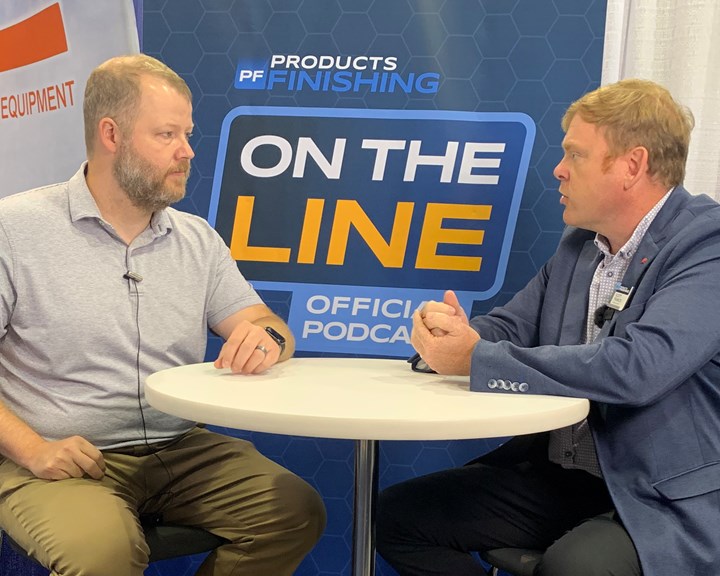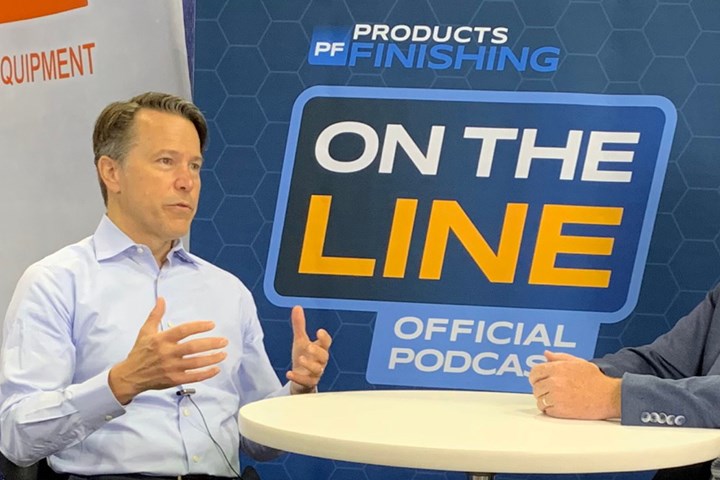Episode 21: Interviews From SUR/FIN 2022
Conversations from the trade show floor on the finishing community’s response to increased hexavalent chrome and PFAS fume suppressant regulations.
The National Association for Surface Finishing (NASF) SUR/FIN finishing industry tradeshow always provides a great opportunity to compare notes on the topics that are of the greatest concern for the finishing community. In this month’s installment of Products Finishing’s On the Line podcast, we highlight some of the conversations we had at the show regarding the industry’s collaborative response to increasing regulatory pressure to transition existing hexavalent chrome to trivalent chromium.
Listen to the full podcast interview (above) or check out the following excerpt:

Josh Fish, technical director, PAVCO
PF: As platers consider adding trivalent chrome capabilities or transition their current capabilities, what are some things they need to be aware of?
JF: The chemistry is proven — it’s been in the market for 30 plus years. Now it will be important to educate the platers that operating trivalent will be different from hexavalent. The biggest transition concern that we see is with the plater being able to continue to produce hexavalent parts while adding and testing out trivalent. You will need extra space in the line to either add Cr(III) at the end or be able to shuttle over to produce Cr(III). This will allow the plater to be able to produce both finishes simultaneously.
When it comes to operational best practices, people love hex-chrome because it’s very forgiving. You only have three or four main parameters that you need to look at.
With trivalent you have to filter it; you need ion exchange to keep the contaminant metals down; you have to analyze it more frequently; you will need to run hull cells on it. You will need to treat it almost like a nickel bath, but the good thing is that these platers are already used to operating nickel baths. It’s just having to switch that mindset of not really having to worry about the chrome tank to thinking of it like a true process tank.

Mark Schario, executive vice president, Columbia Chemical
PF: While trivalent chromium isn’t new on the market, there’s a lot of interest in it as regulations for hexavalent chromium use become increasingly stringent. What’s your take on where things are at with the adoption of trivalent chromium with regards to the automotive supply chain?
MS: I can’t really speak in too much detail about the OEMs as to when they’ll convert. I can say that they have been working hard over the last five years. They’ve developed AIAG (Automotive Industry Action Group) standards for trivalent deposits, so that when it does happen, they’re ready to go. U.S. CAR (United States Council for Automotive Research) is actually working on developing a new standard with ASTM (American Society for Testing and Materials) to measure the thickness of tri-chrome. To me, the most important evidence is they already have the white tri-chrome color masters developed that they want to have. So as soon as the regulations move forward, I feel they’re ready. As a supply chain we just need to prepare for this, be proactive, and get ready.
PF: What was the tone of this discussion like at SUR/FIN this year?
MS: Well, I have to say that this year is the first time I’ve seen OEMs, suppliers and platers all get together to say how are we going to cope with these new regulations — how do we be proactive? The metal finishing industry has always been very responsible. This time I also see some optimism — everybody’s really working together to make this happen in an organized fashion.

Christian Richter, the Policy Group representing the NASF
PF: Can you speak about the work that the NASF has been doing to facilitate policy discussions surrounding hexavalent chromium and PFAS fume suppressant regulations?
CR: Both of these issues [hexavalent chromium and PFAS] are very complex. They’re challenging from both a policy standpoint and an execution standpoint to actually make these big leaps happen across the industry supply chain from the manufacturers and suppliers to the applicators and the automotive OEMs.
I think what’s really important is that we always show up first to regulators when they see that there’s something new and potentially problematic or challenging on the horizon. Our point in doing this is to defend the industry against regulations that can impose unjustified costs or stretch the industry in ways that aren’t viable.
We want to make sure that we put the solutions on the table voluntarily, and proactively work with all the right stakeholders in our community, and with our government to ensure that the right decisions get made.
Related Content
How to Choose Between Sulfate and Chloride-Based Trivalent Chromium
There are several factors to consider when choosing between sulfate and chloride-based baths for trivalent chromium plating. Mark Schario of Columbia Chemical discusses the differences and what platers should keep in mind when evaluating options.
Read MoreProducts Finishing Reveals 2023 Qualifying Top Shops
Each year PF conducts its Top Shops Benchmarking Survey, offering shops a tool to better understand their overall performance in the industry. The program also recognizes shops that meet a set of criteria to qualify as Top Shops.
Read MoreA Chromium Plating Overview
An overview of decorative and hard chromium electroplating processes.
Read More3 Tests to Ensure Parts are Clean Prior to Plating
Making sure that all of the pre-processing fluids are removed prior to plating is not as simple as it seems. Rich Held of Haviland Products outlines three tests that can help verify that your parts are clean.
Read MoreRead Next
Episode 6: Transitioning Hexavalent Chromium to Trivalent, Part 2
In this episode of On the Line, Products Finishing editor-in-chief Scott Francis sits down with Bryan Leiker and Justin Guzman representing the Metal Finishers Association of California to discuss the impact of California’s recently proposed transition deadlines for hexavalent chromium plating to trivalent chromium alternatives.
Read MoreEpisode 15: The Quest to Make Chrome Safe
In this episode of On the Line, we hear about a new non-aqueous trivalent chromium chemistry.
Read MoreThe Continuing Battle Over Hex Chrome
The latest in the California regulatory battle over the phase-out of hexavalent chromium use in finishing operations.
Read More















